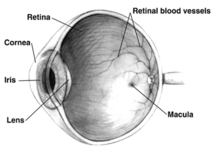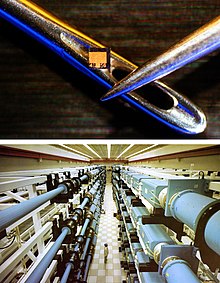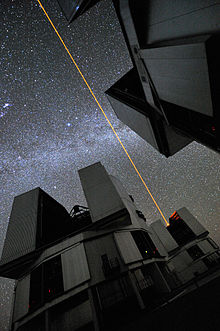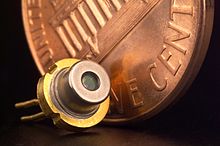Stealth technology (or LO for "low observability") is not a single technology. It is a combination of technologies that attempt to greatly reduce the distances at which a person or vehicle can be detected; in particular radar cross section reductions, but also acoustic, thermal, and other aspects:
Radar cross-section (RCS) reductions
Almost since the invention of radar, various methods have been tried to minimize detection. Rapid development of radar during WWII led to equally rapid development of numerous counter radar measures during the period; a notable example of this was the use of chaff.
The term "stealth" in reference to reduced radar signature aircraft became popular during the late eighties when the Lockheed Martin F-117 stealth fighter became widely known. The first large scale (and public) use of the F-117 was during the Gulf War in 1991. However, F-117A stealth fighters were used for the first time in combat during Operation Just Cause, the United States invasion of Panama in 1989. Increased awareness of stealth vehicles and the technologies behind them is prompting the development of means to detect stealth vehicles, such as passive radar arrays and low-frequency radars. Many countries nevertheless continue to develop low-RCS vehicles because they offer advantages in detection range reduction and amplify the effectiveness of on-board systems against active radar guidance threats.
Vehicle shape
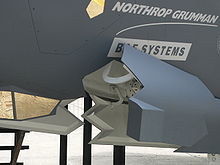
The F-35 Lightning II offers better stealthy features (such as this landing gear door) than prior American fighters, such as the F-16 Fighting Falcon
The possibility of designing aircraft in such a manner as to reduce their radar cross-section was recognized in the late 1930s, when the first radar tracking systems were employed, and it has been known since at least the 1960s that aircraft shape makes a significant difference in detectability. The Avro Vulcan, a British bomber of the 1960s, had a remarkably small appearance on radar despite its large size, and occasionally disappeared from radar screens entirely. It is now known that it had a fortuitously stealthy shape apart from the vertical element of the tail. In contrast, the Tupolev 95 Russian long range bomber (NATO reporting name 'Bear') appeared especially well on radar. It is now known that propellers and jet turbine blades produce a bright radar image[citation needed]; the Bear had four pairs of large (5.6 meter diameter) contra-rotating propellers.
Another important factor is internal construction. Some stealth aircraft have skin that is radar transparent or absorbing, behind which are structures termed re-entrant triangles. Radar waves penetrating the skin get trapped in these structures, reflecting off the internal faces and losing energy. This method was first used on the Blackbird series (A-12 / YF-12A / SR-71).
The most efficient way to reflect radar waves back to the emitting radar is with orthogonal metal plates, forming a corner reflector consisting of either a dihedral (two plates) or a trihedral (three orthogonal plates). This configuration occurs in the tail of a conventional aircraft, where the vertical and horizontal components of the tail are set at right angles. Stealth aircraft such as the F-117 use a different arrangement, tilting the tail surfaces to reduce corner reflections formed between them. A more radical method is to eliminate the tail completely, as in the B-2 Spirit.
In addition to altering the tail, stealth design must bury the engines within the wing or fuselage, or in some cases where stealth is applied to an extant aircraft, install baffles in the air intakes, so that the turbine blades are not visible to radar. A stealthy shape must be devoid of complex bumps or protrusions of any kind; meaning that weapons, fuel tanks, and other stores must not be carried externally. Any stealthy vehicle becomes un-stealthy when a door or hatch opens.
Planform alignment is also often used in stealth designs. Planform alignment involves using a small number of surface orientations in the shape of the structure. For example, on the F-22A Raptor, the leading edges of the wing and the tail surfaces are set at the same angle. Careful inspection shows that many small structures, such as the air intake bypass doors and the air refueling aperture, also use the same angles. The effect of planform alignment is to return a radar signal in a very specific direction away from the radar emitter rather than returning a diffuse signal detectable at many angles.
Stealth airframes sometimes display distinctive serrations on some exposed edges, such as the engine ports. The YF-23 has such serrations on the exhaust ports. This is another example in the use of re-entrant triangles and planform alignment, this time on the external airframe.
Shaping requirements have strong negative influence on the aircraft's aerodynamic properties. The F-117 has poor aerodynamics, is inherently unstable, and cannot be flown without a fly-by-wire control system.
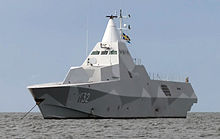
K32 HMS Helsingborg, a stealth ship
Ships have also adopted similar methods. The Skjold class patrol boat was the first stealth ship to enter service, though the earlier Arleigh Burke class destroyer incorporated some signature-reduction features. Other examples are the French La Fayette class frigate, the German Sachsen class frigates, the Swedish Visby class corvette, the USS San Antonio amphibious transport dock, and most modern warship designs.
Similarly, coating the cockpit canopy with a thin film transparent conductor (vapor-deposited gold or indium tin oxide) helps to reduce the aircraft's radar profile, because radar waves would normally enter the cockpit, reflect off objects (the inside of a cockpit has a complex shape, with a pilot helmet alone forming a sizeable return), and possibly return to the radar, but the conductive coating creates a controlled shape that deflects the incoming radar waves away from the radar. The coating is thin enough that it has no adverse effect on pilot vision.
Non-metallic airframe
Dielectric composites are more transparent to radar, whereas electrically conductive materials such as metals and carbon fibers reflect electromagnetic energy incident on the material's surface. Composites may also contain ferrites to optimize the dielectric and magnetic properties of a material for its application.
Radar-absorbing material
Radar-absorbent material (RAM), often as paints, are used especially on the edges of metal surfaces. While the material and thickness of RAM coatings is classified, the material seeks to absorb radiated energy from a ground or air based radar station into the coating and convert it to heat rather than reflect it back.
Radar stealth countermeasures and limits
Low-frequency radar
Shaping offers far fewer stealth advantages against low-frequency radar. If the radar wavelength is roughly twice the size of the target, a half-wave resonance effect can still generate a significant return. However, low-frequency radar is limited by lack of available frequencies-many are heavily used by other systems, by lack of accuracy of the diffraction-limited systems given their long wavelengths, and by the radar's size, making it difficult to transport. A long-wave radar may detect a target and roughly locate it, but not provide enough information to identify it, target it with weapons, or even to guide a fighter to it. Noise poses another problem, but that can be efficiently addressed using modern computer technology; Chinese "Nantsin" radar and many older Soviet-made long-range radars were modified this way. It has been said that "there's nothing invisible in the radar frequency range below 2 GHz".
Multiple emitters
Much of the stealth comes from reflecting radar emissions in directions different than a direct return. Thus, detection can be better achieved if emitters are separate from receivers. One emitter separate from one receiver is termed bistatic radar; one or more emitters separate from more than one receiver is multitatic. Proposals exist to use reflections from emitters such as civilian radio transmitters, including cellular telephone radio towers.
Moore's law
By Moore's law the processing power behind radar systems is rising over time. This will erode the ability of physical stealth to hide vehicles.
Ship's wakes and spray
Synthetic Aperture sidescan radars can be used to detect the location and heading of ships from their wake patterns. These may be detectable from orbit. When a ship moves through a seaway it throws up a cloud of spray which can be detected by radar.
Acoustics
Acoustic stealth plays a primary role in submarine stealth as well as for ground vehicles. Submarines use extensive rubber mountings to isolate and avoid mechanical noises that could reveal locations to underwater passive sonar arrays.
Early stealth observation aircraft used slow-turning propellers to avoid being heard by enemy troops below. Stealth aircraft that stay subsonic can avoid being tracked by sonic boom. The presence of supersonic and jet-powered stealth aircraft such as the SR-71 Blackbird indicates that acoustic signature is not always a major driver in aircraft design, although the Blackbird relied more on its extremely high speed and altitude.
Visibility
The simplest stealth technology is simply camouflage; the use of paint or other materials to color and break up the lines of the vehicle or person.
Most stealth aircraft use matte paint and dark colors, and operate only at night. Lately, interest in daylight Stealth (especially by the USAF) has emphasized the use of gray paint in disruptive schemes, and it is assumed that Yehudi lights could be used in the future to mask shadows in the airframe (in daylight, against the clear background of the sky, dark tones are easier to detect than light ones) or as a sort of active camouflage. The original B-2 design had wing tanks for a contrail-inhibiting chemical, alleged by some to be chlorofluorosulfonic acid, but this was replaced in the final design with a contrail sensor from Ophir that alerts the pilot when he should change altitude and mission planning also considers altitudes where the probability of their formation is minimized.
Infrared
An exhaust plume contributes a significant infrared signature. One means to reduce IR signature is to have a non-circular tail pipe (a slit shape) to minimize the exhaust cross-sectional volume and maximize the mixing of hot exhaust with cool ambient air. Often, cool air is deliberately injected into the exhaust flow to boost this process. Sometimes, the jet exhaust is vented above the wing surface to shield it from observers below, as in the B-2 Spirit, and the unstealthy A-10 Thunderbolt II. To achieve infrared stealth, the exhaust gas is cooled to the temperatures where the brightest wavelengths it radiates are absorbed by atmospheric carbon dioxide and water vapor, dramatically reducing the infrared visibility of the exhaust plume. Another way to reduce the exhaust temperature is to circulate coolant fluids such as fuel inside the exhaust pipe, where the fuel tanks serve as heat sinks cooled by the flow of air along the wings.[citation needed]
Ground combat includes the use of both active and passive infrared sensors and so the USMC ground combat uniform requirements document specifies infrared reflective quality standards.
Reducing radio frequency (RF) emissions
In addition to reducing infrared and acoustic emissions, a stealth vehicle must avoid radiating any other detectable energy, such as from onboard radars, communications systems, or RF leakage from electronics enclosures. The F-117 uses passive infrared and low light level television sensor systems to aim its weapons and the F-22 Raptor has an advanced LPI radar which can illuminate enemy aircraft without triggering a radar warning receiver response.
Measuring
The size of a target's image on radar is measured by the radar cross section or RCS, often represented by the symbol σ and expressed in square meters. This does not equal geometric area. A perfectly conducting sphere of projected cross sectional area 1 m2 (i.e. a diameter of 1.13 m) will have an RCS of 1 m2. Note that for radar wavelengths much less than the diameter of the sphere, RCS is independent of frequency. Conversely, a square flat plate of area 1 m2 will have an RCS of σ = 4π A2 / λ2 (where A=area, λ=wavelength), or 13,982 m2 at 10 GHz if the radar is perpendicular to the flat surface. At off-normal incident angles, energy is reflected away from the receiver, reducing the RCS. Modern stealth aircraft are said to have an RCS comparable with small birds or large insects, though this varies widely depending on aircraft and radar.
If the RCS was directly related to the target's cross-sectional area, the only way to reduce it would be to make the physical profile smaller. Rather, by reflecting much of the radiation away or by absorbing it, the target achieves a smaller radar cross section.
Tactics
Stealthy strike aircraft such as the F-117, designed by Lockheed Martin's famous Skunk Works, are usually used against heavily defended enemy sites such as Command and Control centers or surface-to-air missile (SAM) batteries. Enemy radar will cover the airspace around these sites with overlapping coverage, making undetected entry by conventional aircraft nearly impossible. Stealthy aircraft can also be detected, but only at short ranges around the radars, so that for a stealthy aircraft there are substantial gaps in the radar coverage. Thus a stealthy aircraft flying an appropriate route can remain undetected by radar. Many ground-based radars exploit Doppler filter to improve sensitivity to objects having a radial velocity component with respect to the radar. Mission planners use their knowledge of enemy radar locations and the RCS pattern of the aircraft to design a flight path that minimizes radial speed while presenting the lowest-RCS aspects of the aircraft to the threat radar. To be able to fly these "safe" routes, it is necessary to understand an enemy's radar coverage (see Electronic Intelligence). Airborne or mobile radar systems such as AWACS can complicate tactical strategy for stealth operation.
Research
Negative index metamaterials are artificial structures which refractive index has a negative value for some frequency range, such as in microwave, infrared, or possibly optical. These offer another way to reduce detectability, and may provide electromagnetic near-invisibility in designed wavelengths.
Plasma stealth is a phenomenon proposed to use ionized gas (plasma) to reduce RCS of vehicles. Interactions between electromagnetic radiation and ionized gas have been studied extensively for many purposes, including concealing vehicles from radar. Various methods might form a layer or cloud of plasma around a vehicle to deflect or absorb radar, from simpler electrostatic to RF more complex laser discharges, but these may be difficult in practice.
Several technology research and development efforts exist to integrate the functions of aircraft flight control systems such as ailerons, elevators, elevons, flaps, and flaperons into wings to perform the aerodynamic purpose with the advantages of lower RCS for stealth via simpler geometries and lower complexity (mechanically simpler, fewer or no moving parts or surfaces, less maintenance), and lower mass, cost (up to 50% less), drag (up to 15% less during use) and, inertia (for faster, stronger control response to change vehicle orientation to reduce detection). Two promising approaches are flexible wings, and fluidics.
In flexible wings, much or all of a wing surface can change shape in flight to deflect air flow. The X-53 Active Aeroelastic Wing is a NASA effort. The Adaptive Compliant Wing is a military and commercial effort.
In fluidics, fluid injection is being researched for use in aircraft to control direction, in two ways: circulation control and thrust vectoring. In both, larger more complex mechanical parts are replaced by smaller, simpler fluidic systems, in which larger forces in fluids are diverted by smaller jets or flows of fluid intermittently, to change the direction of vehicles.
In circulation control, near the trailing edges of wings, aircraft flight control systems are replaced by slots which emit fluid flows.
In thrust vectoring, in jet engine nozzles, swiveling parts are replaced by slots which inject fluid flows into jets to divert thrust.
Tests show that air forced into a jet engine exhaust stream can deflect thrust up to 15 degrees. The U.S. FAA has conducted a study about civilizing 3D military thrust vectoring to help jetliners avoid crashes. According to this study, 65% of all air crashes can be prevented by deploying thrust vectoring means.







